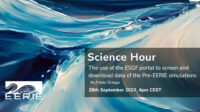BSC’s Eneko Martín-Martínez hosts the eighth Science Hour, on the impact of model resolution on the representation of deep-water formation and its link with the AMOC.
Recent supercomputing power improvements and a new generation of more efficient high-resolution climate models have enabled us to explore climate variability and change with coupled models that resolve the ocean mesoscale, its fine-scale interactions and feedbacks. Although these processes are usually parametrised in standard resolutions, several studies have already shown that effectively resolving them leads to reduced model biases in the ocean and improved air-sea interactions.
In this study, we use 1950 control simulations with the global climate model EC-Earth3P following the HighResMIP protocol to investigate the role of fine-scale processes in large-scale ocean circulation in the Atlantic. In particular, we work with three configurations of the model: eddy-parameterised (~100 km nominal horizontal resolution in mid-latitudes), eddy-permitting (~25 km) and eddy-resolving oceans (~10 km).
For each model configuration, we have studied the mean state and variability of the mixed-layer depth in the subpolar North Atlantic, exploring how the horizontal resolution affects its drivers and preconditioners (which include the background stratification, the local buoyancy forcing from the atmosphere, and the advection of salinity and temperature anomalies by the mean circulation). We have additionally investigated its ultimate link the Atlantic Meridional Overturning Circulation (AMOC) through its influence on the southward propagation of density anomalies along the western boundary current, which has revealed important differences across resolutions.




